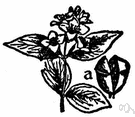syringa
(redirected from syringas)Also found in: Thesaurus, Encyclopedia.
sy·rin·ga
(sə-rĭng′gə)n.
A mock orange shrub.
[New Latin, from Greek surinx, suring-, shepherd's pipe (from the use of its hollow stems to make pipes).]
American Heritage® Dictionary of the English Language, Fifth Edition. Copyright © 2016 by Houghton Mifflin Harcourt Publishing Company. Published by Houghton Mifflin Harcourt Publishing Company. All rights reserved.
syringa
(sɪˈrɪŋɡə)n
(Plants) another name for mock orange, lilac1
[C17: from New Latin, from Greek surinx tube, alluding to the use of its hollow stems for pipes]
Collins English Dictionary – Complete and Unabridged, 12th Edition 2014 © HarperCollins Publishers 1991, 1994, 1998, 2000, 2003, 2006, 2007, 2009, 2011, 2014
mock′ or′ange
n.
1. Also called syringa. any of various shrubs belonging to the genus Philadelphus, of the saxifrage family, having white, often fragrant flowers.
2. any of various other shrubs or trees having flowers or fruit resembling those of the orange.
[1725–35]
Random House Kernerman Webster's College Dictionary, © 2010 K Dictionaries Ltd. Copyright 2005, 1997, 1991 by Random House, Inc. All rights reserved.
ThesaurusAntonymsRelated WordsSynonymsLegend:
Switch to new thesaurus
| Noun | 1. |  syringa - large hardy shrub with showy and strongly fragrant creamy-white flowers in short terminal racemes syringa - large hardy shrub with showy and strongly fragrant creamy-white flowers in short terminal racemesgenus Philadelphus - mock orange: type and sole genus of the subfamily Philadelphaceae; sometimes placed in family Saxifragaceae philadelphus - any of various chiefly deciduous ornamental shrubs of the genus Philadelphus having white sweet-scented flowers, single or in clusters; widely grown in temperate regions |
| 2. | Syringa - genus of Old World shrubs or low trees having fragrant flowers in showy panicles: lilacs dicot genus, magnoliopsid genus - genus of flowering plants having two cotyledons (embryonic leaves) in the seed which usually appear at germination family Oleaceae, Oleaceae, olive family - trees and shrubs having berries or drupes or capsules as fruits; sometimes placed in the order Oleales: olive; ash; jasmine; privet; lilac lilac - any of various plants of the genus Syringa having large panicles of usually fragrant flowers |
Based on WordNet 3.0, Farlex clipart collection. © 2003-2012 Princeton University, Farlex Inc.
Translations
syringa
Collins German Dictionary – Complete and Unabridged 7th Edition 2005. © William Collins Sons & Co. Ltd. 1980 © HarperCollins Publishers 1991, 1997, 1999, 2004, 2005, 2007